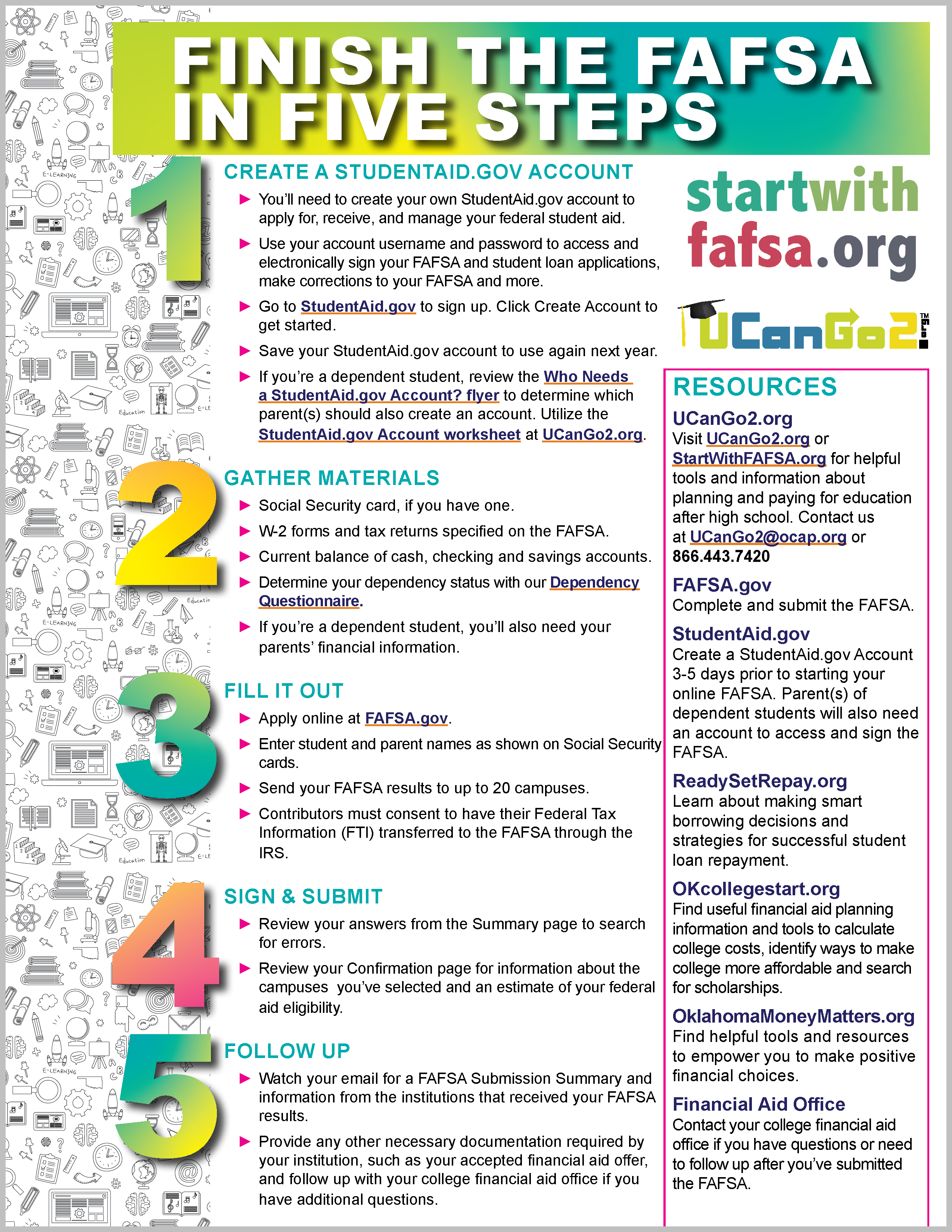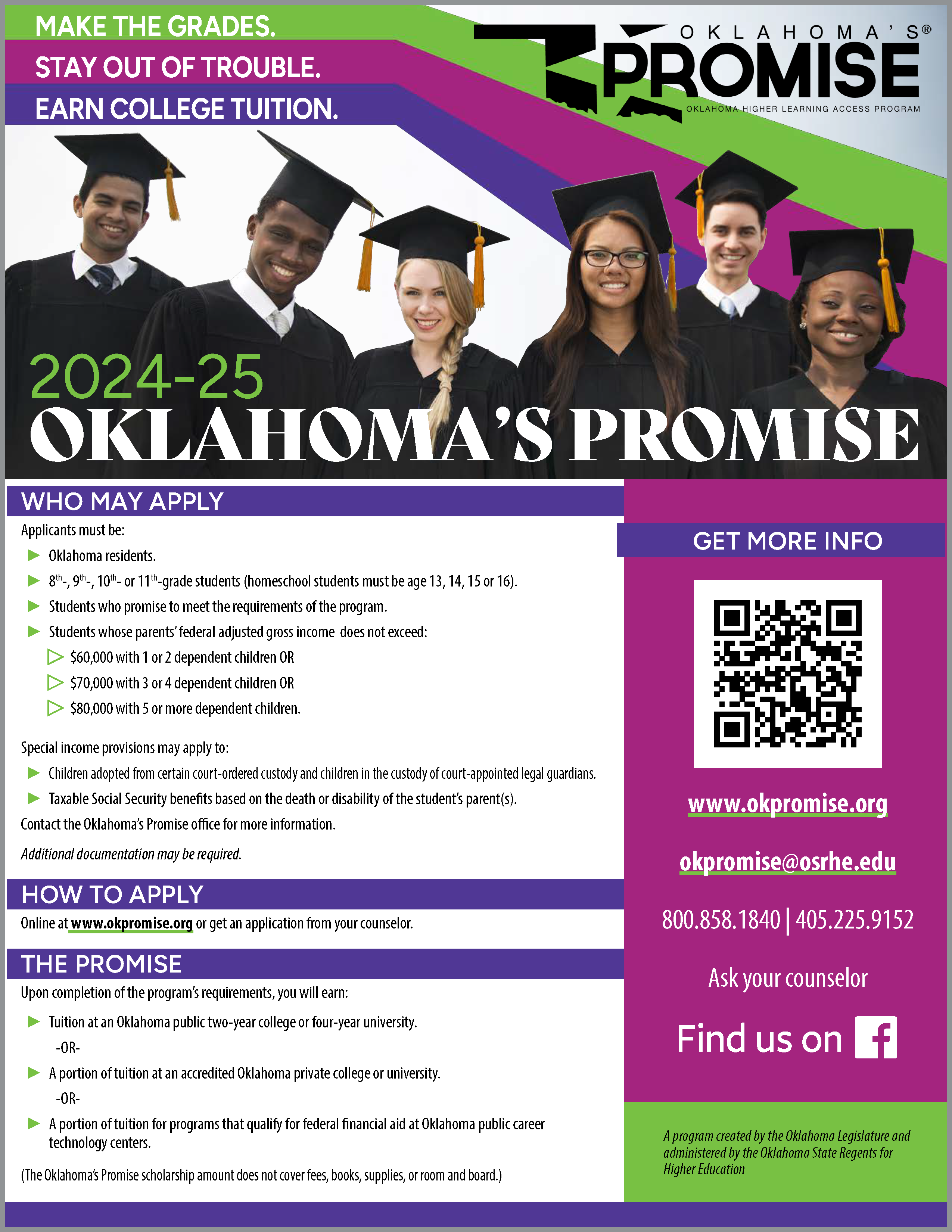Paying for College
The Steps to Take in High School
When it comes to paying for college, it's important to have a plan. The cost of room and board, fees and tuition vary at each college, and you'll also need to account for living expenses and books while you're in school. While that may seem overwhelming, keep in mind there are many sources of financial aid available. The earlier you start saving money for college and applying for aid, like grants and scholarships, the better. Use the tabs below to learn about different types of financial aid that may be available to you.
- Savings
- FAFSA
- Grants/Scholarships
- State Aid
- Work-Study
- Student Loans
Savings
It's never too late to start saving for college. Even a small amount tucked away can help make ends meet when you're on a tight budget in school. Consider saving your birthday money, left-over allowance or extra money from a part-time job. The earlier you start saving, the more you'll have. Remember to keep savings accounts under your parent/guardian’s name to help maximize your federal financial aid qualifications.
Talk to your parents about the possibility of setting up a 529 College Savings Plan. In Oklahoma, you do not have to pay taxes on 529 account earnings and those with a 529 plan receive an Oklahoma tax deduction. A 529 College Savings Plan is a specific savings account that allows your loved ones to set aside money for your future education. Funds from this account can only be used on college expenses such as tuition, fees, room and board, books and other miscellaneous education purposes. Learn more about 529 College Savings Plans at www.oklahoma529.com.
Next tab: "FAFSA"
FAFSA
The first step in receiving any type of federal financial aid is to complete the Free Application for Federal Student Aid (FAFSA). Federal student aid includes grants, work-study opportunities and student loans. The FAFSA is also required for some scholarships. If you’re not a senior in high school yet, you have some time before you'll need to complete the form.
If you are a high school senior, you'll need to submit the form this year to find out what federal and state financial aid options are available to you.
Most importantly:
- Complete the FAFSA as soon as it becomes available each year, beginning with your senior year of high school. Remember, you'll need to submit the FAFSA each year of college in order to stay eligible for federal financial aid.
- The first letter in FAFSA stands for FREE. Never pay to complete the application.
- Even if you don't think you'll qualify for financial aid, submit the FAFSA anyway. Most students qualify for some type of financial assistance for college.
- The easiest and most efficient way to complete the FAFSA is through the official FAFSA website, FAFSA.gov.
For more information about the FAFSA, including resources, publications and answers to your questions, visit us at StartWithFAFSA.org.

Next tab: "Grants/Scholarships"
Previous tab: "Savings"
Grants/Scholarships
 We refer to grants and scholarships as "free money" or "gift aid" because it's money you can use for college that you won't have to pay back. When looking for money for college, it's best to seek free money before seeking student loans.
We refer to grants and scholarships as "free money" or "gift aid" because it's money you can use for college that you won't have to pay back. When looking for money for college, it's best to seek free money before seeking student loans.
Grants and scholarships are offered to college students for a variety of reasons, not just perfect grades. And, they are available through many sources including your state, your college, private organizations and the government.
Be sure to check out local organizations that sponsor scholarships, such as your church and community groups. Check out our scholarships page to search for scholarships by deadline or category.
Remember, scholarships are awarded based on a variety of criteria, including need, merit, residency, family history, skills, hobbies, volunteer work and athletics. Scholarship application deadlines vary, with some due before you graduate high school. Check out your local library to find scholarships and use our Scholarship Success Guide to help improve the quality of your applications. For the best results, high school juniors and seniors should try to apply for two to three scholarships each week.
The U.S. Department of Education offers a variety of federal grants to students attending four-year colleges or universities, community colleges and career technology centers. Applicants must complete the FAFSA to apply for each of these programs:
- Federal Pell Grants are provided to undergraduate students with financial need, who have not earned their first bachelor’s or professional degree.
- Federal Supplemental Educational Opportunity Grants (FSEOG) are offered to students who have the highest financial need. Not all schools participate in this program.
- Teacher Education Assistance for College and Higher Education (TEACH) Grant is different from other federal student grants because it requires students to take certain kinds of classes in order to receive the grant, and then do a certain kind of job to keep the grant from turning into a loan.
- Iraq and Afghanistan Service Grants provide money to college or career school students to help pay their education expenses. Eligible recipients must also meet these requirements:
- The student is not eligible for a Federal Pell Grant on the basis of their Expected Family Contribution, but
- meets the remaining Federal Pell Grant eligibility requirements, and
- student’s parent or guardian was a member of the U.S. armed forces and died as a result of military service performed in Iraq or Afghanistan after the events of 9/11, and
- student is under 24 years of age or enrolled in college at least part-time at the time of their parent’s or guardian’s death.
Next tab: "State Aid"
Previous tab: "FAFSA"
State Aid
Did you know Oklahoma provides millions of dollars in free grants and scholarships to qualified students each year? Our state offers several programs you'll want to check out:
Oklahoma Tuition Aid Grant (OTAG) Program
OTAG awards grants to eligible Oklahoma students who need money to meet part of the cost of attending college or a career technology center. Students must submit the Free Application for Federal Student Aid (FAFSA) to apply for this grant. Grant funds may be limited, so the earlier the better.Oklahoma Tuition Equalization Grant (OTEG)
OTEG awards grants to Oklahoma students attending qualifying Oklahoma not-for-profit, private or independent institutions. Family income cannot exceed $50,000.Oklahoma's Promise
Students must apply in the 8th, 9th, 10th or 11th grade, be a resident of Oklahoma, complete a specific high school curriculum, achieve at least a 2.50 GPA both in the curriculum and overall, and abide by certain conduct standards. The federal adjusted gross income of the student’s family may not exceed:
- $60,000 with 1 or 2 dependent children OR
- $70,000 with 3 or 4 dependent children OR
- $80,000 with 5 or more dependent children.
In addition, the family income must not exceed $100,000 each year the student is enrolled in postsecondary education (students must complete the FAFSA each year). Oklahoma’s Promise will pay resident tuition at a public college or a portion of tuition at private institutions or public technology centers in Oklahoma.
Academic Scholars Program
The Academic Scholars Program awards scholarships to Oklahoma students who score at or above the 99.5 percentile on the ACT or SAT exam. It's also given to in-state and out-of-state students who are named National Merit Scholars or finalists, Presidential Scholars or Institutional Nominees (non-resident participation is limited).
Next tab: "Work Study"
Previous tab: "Grants/Scholarships "
The Federal Work-Study Program
The Federal Work-Study program provides job opportunities for college students with financial need. The program encourages you to work for your school or to perform work related to your major. Like a regular job, you work a set schedule and get paid an hourly wage. The application for this program is only available through the FAFSA. Visit StudentAid.gov to learn about the work-study program and other types of federal aid.
Even if you don't qualify for the Federal Work-Study program, working through school can be a great idea, provided you can handle your responsibilities as a student, too. Every dollar you earn is one less dollar you'll need to borrow. Many colleges offer part-time jobs to their students apart from the work-study program. Check with your school's student life department to find out what's available.
Next tab: "Student Loans"
Previous tab: "State Aid"
Student Loans
 You may need to consider student loans to help close the gap between money you've earned/saved and college expenses. Like any other loan, when you take out a student loan, you're making a promise to pay the borrowed money back. Even if you don't graduate, you still have to pay back every dollar you borrow, plus interest.
You may need to consider student loans to help close the gap between money you've earned/saved and college expenses. Like any other loan, when you take out a student loan, you're making a promise to pay the borrowed money back. Even if you don't graduate, you still have to pay back every dollar you borrow, plus interest.
Here are some tips to consider when borrowing student loans:
- Do your homework.
There are two categories of loans: federal student loans and private loans (sometimes called alternative loans). If you have to borrow to pay for school, do some research. Federal loans often have lower interest rates and flexible repayment options. However, some private loans are becoming more competitive, so take the time to research your options. You'll want the best program available to you. - Borrow only what you need.
When accepting a student loan, know how much money you'll actually need to cover your school expenses, including your basic living expenses for the school term. Many students are offered more loan funds than they actually need. Remember, you don't have to accept all funds offered to you. Be cautious in pursuing additional loans outside those recommended by your financial aid office. - Be salary savvy.
Consider the starting salary for your chosen occupation before taking out student loans. A good rule of thumb is to make sure your student loan payments won't exceed 8 percent of your starting monthly income after graduation. - Don't charge it.
If possible, don't rely on credit cards for tuition or school-related expenses. Some families think it's easier to charge all college expenses to a credit card to avoid completing financial aid paperwork, but the interest on student loans is usually far less than interest on credits cards.
For more tips about student loans, download our Borrow Smart from the Start brochure.
Previous tab: "Work Study"





